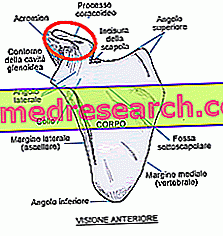Scrofula or scrofula is an infection of the lymph nodes of the neck better called tuberculous adenitis . It is an infectious disease generated by mycobacteria; in the adult it is often caused by Mycobacterium tubercolosis or scrofulaceum (also responsible for the much more known and lethal pulmonary tuberculosis ) which, in this case, penetrates the lymphatic circulation and affects some lymph nodes, above all those below the jaw; in contrast, scrofula or scrofula in children is caused by other "NON-tubercular or atypical" mycobacteria such as the Nontuberculous mycobacteria .

spread
The greatest spread of scrofula or scrofula occurred in Europe (France and England) between the 10th and 17th centuries, when it was believed that it could be cured by the "touch" of a noble; today, despite being considered a rare disease, it represents a possible complication of immunodepression and / or secondarily of severe malnutrition (eg that caused by the HIV virus).
Symptoms
The scrofula or scrofula begins with the disproportionate enlargement of the glands in the neck, with a greater fusion on those at the base of the jaw; this lymphadenopathy is associated with cutaneous, mucous and sometimes bony manifestations; the impairment of the lymph nodes is painless but, if left untreated, acquires a hard-elastic consistency and reaches or exceeds 2 centimeters in diameter for each lymph node ( lymphadenomegaly ). Sometimes it causes AGGREGATIONS and profoundly distorts the features of those affected.
Scrofula or scrofula is distinguished from most infectious diseases by the absence of localized inflammation (without "redness-heat"), resulting in a peculiar swelling called "cold abscess".
At the systemic level, scrofula or scrofula causes fever and chills typical of serious infections.
Induced deformations
The term scrofula or scrofula (also known as scrofula or scrofolosic infection) originates from the profound malformations that this pathology determines on untreated subjects; the affected lymph nodes, in particular those that merge into masses of considerable size, sometimes provoke the rupture of the overlying skin and the explosion of the abscess ( fistula ) with abundant leakage of pus . It is therefore deducible that, even assuming total pathological remission, the retraent scars of the fistulas caused by scrofula or scrofula are deforming and permanent.
As anticipated, in addition to the damage of the glands in the neck, there are lesions of the ocular mucous membranes ( keratose-phytothecular conjunctivitis ), nasal lesions, of the lips ( peri-buccal ), eczema of the face and scalp ( scrofulodermi - tuberculidi ) and swelling of the nose and of the upper lip ... but also periosteum thickening of the phalanges of hands and feet. These deformations, associated with the retraent scars of the fistulas or, even worse, to the expression of lymphomegalic aggregates, gives the sick (especially children) the typical appearance of a pig ( facies scrofola ). From all this originates the name scrofula or scrofula.
Therapy
The scrofula or scrofula therapy is mainly antibiotic, antituberculous and sea climatic chemotherapy (rest, abundant nutrition, life in the open air, heliotherapy etc.); in some cases, especially those generated by the Nontuberculous mycobacteria, surgical removal of the abscesses is necessary, but pharmacological aid remains of primary importance.
NB . Throughout history, some specialists have recognized poppy seed oil as a useful and therapeutic food against scrofula or scrofula; on the other hand, it is also appropriate to specify that some subjects suffering from this disease (especially children after puberty) have enjoyed totally spontaneous pathological resolutions. Ultimately, it is not easy to define the real utility of poppy seed oil in the treatment of scrofula or scrofula that affects younger subjects.
Climatic therapy at sea: importance of heliotherapy (heliotherapy) and iodine in the remission of scrofula or scrofula and in other diseases
Climatic therapy is a very ancient healing method; it is very useful both in the treatment of various infections, among which the aforementioned scrofula or scrofula (on which it acts in a polyvalent manner), and in other etiologically different disorders such as: rickets, rheumatism, osteoporosis, arthrosis, eczema, psoriasis, depression, anxiety, etc.
It is based on the therapeutic efficacy of the integumentary (skin) exposure to sunlight with humidity and ventilation typical of the maritime climate; the relative mechanisms of action are of various kinds: first, there is a marked endogenous synthesis of vit. D, necessary for calcium metabolism, therefore useful for ossification. The dryness of the air and the heat from direct (but moderate) irradiation of the sun are not to be neglected, fundamental in the course of some skin diseases and useful for the remission of rheumatism; we also remember that the lack or excess of some hormones responsible for psychiatric illnesses, such as depression or anxiety states, can be largely improved by exposure to sunlight with a positive effect on healing or moderating symptoms.
The beneficial effect of environmental and food iodine is also very important in heliotherapy; this microelement, potentially lacking in the diet, is rich in marine fish and iodized salt or in whole salt; its main function is to form part of the thyroid hormones (regulators of metabolism, growth and morphogenesis of some organs and systems) and is particularly useful both for the remission of the scrofula or scrofula of the child, and for the improvement of hypothyroidism (moreover sometimes characterized by neuro-psychic symptoms - depressive symptoms) and indirectly by many other related disorders.



